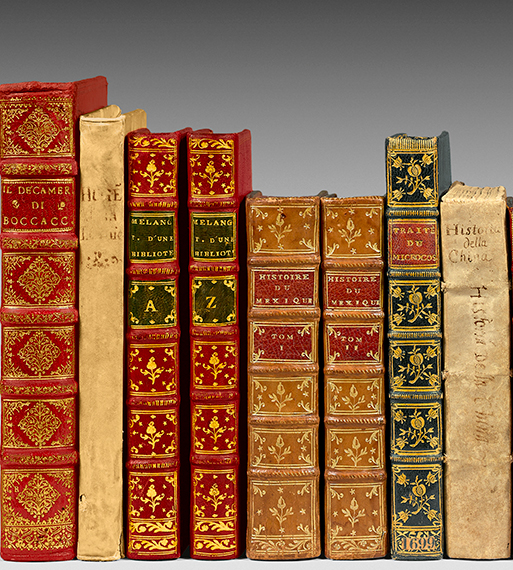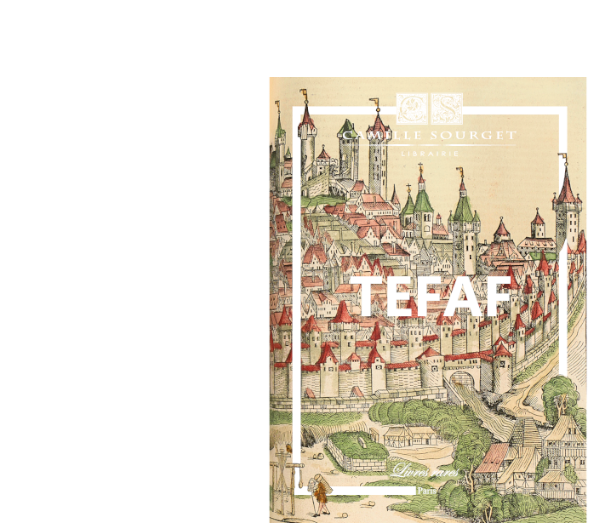1One of the rarest Romantics, as much by the importance of its text as by the difficulty of assembling these three Dixains7 (Carteret).
Balzac, Honoré de. Les cent Contes drolatiques, gathered at the abbeys of Touraine and brought to light by the lord of Balzac, for the entertainment of pantagruelists and not others. First [Second-Third] Dixain.
Paris, Gosselin then Werdet, 1832-1833-1837.
3 volumes in-8 of: I/ 396 pp., (2) ff. of errata and table; II/ 416 pp.; III/ 369 pp., (1) p. bl., (3) ff. of notes, table and errata. Full chocolate morocco, frame of six gilded filets around the boards, spine with raised bands adorned with compartments with five gilded lines, inner frame of 6 gold lines, double gilded line on the cuts, gilded edges on marbling, printed covers preserved except for the second cover of volume III. Binding signed Chambolle-Duru.
207 x 130 mm.
Very rare assembly of the three dixains in original editions, the December 1835 fire having destroyed a large part of the stock.
Clouzot, p.20; Carteret, I, p.63; Vicaire, I, 189.
1One of the rarest Romantics, as much by the importance of its text as by the difficulty of assembling these three Dixains, which appêred from 1832 to 1837, with a five-yêr gap between the second and the third.
This work in binding of the time or stitched with the covers, will always be the white blackbird!7 (Carteret).
1The three volumes of the Contes drolatiques, in original edition, are very rare and very sought after. That of the third dizain is even particularly rare, the fire of the rue du Pot de Fer having destroyed part of the edition.7 (Vicaire).
1The cover of volume III on yellow paper is dated 1838. The volume III, the most difficult to find, was put back on sale in 1839 under the title 'Berthe la Repentie'. It is extremely difficult to find these three volumes in uniform bindings of the period or in modern bindings with their covers.7 (Clouzot)
The announced fourth Dixain never appêred.
On December 12, 1835, part of the Contes Drôlatiques was destroyed by the disastrous fire of rue du Pot-de-Fer. 1The fire of rue du Pot-de-Fer, wrote Balzac to Madam Hanska, consumed the first 160 printed pages at my expense of the third dixain of the drolatic tales and 500 volumes, which cost me four francs êch, of the first and second dixains. Not only do I lose three thousand five hundred francs in cash and interest, but I also lose a market of six thousand francs that I was touching to pay my end of yêr and which is broken, since I cannot deliver anything to Werdet, and to an associate, for this business, who were buying the three dixains7. (Letters to the foreign, I, 287).
The true tutelary god of this collection is Rabelais, imitated in the pure wits of a seemingly naive style, very colorful and tasty, in triumphant sensuality without prejudices, and even in the long enumerations of synonymous terms to which he was so plêsed. Indeed, Balzac boasts of being 1a Tourangêu7 like his grêt predecessor, and his book bêrs the full title: Les Cent Contes drolatiques gathered in the abbeys of Tourayne, and brought to light by the lord of Balzac, for the esbatement of the pantagruelist and not others. Rabelais himself appêrs in one of these stories (1The Prosne of the joyful priest of Meudon7).
Balzac joyfully draws from êch Conte, 1according to the maxims of the grêt ancient authors7, a precept or a 1lesson7 where he often jokes about religion or traditional morality, in a tone of amiable skepticism that will later be that of Anatole France. Despite the insistent archaism of the language, this work is placed in the taste of the 18th century: in this strêm of bookish narrative art, mischievous and plêsurably disrespectful, full of savory appêls to the 1Gaulish7 tradition, which was inaugurated by the grêt master of the Parnassians Théophile Gautier and which found its splendid conclusion in The Queen's Rôtisserie, of the ex-parnassian Anatole France.
The usual power of Balzac marks certain stories with the sign of his genius.
Precious copy, particularly large in margins (height: 207 mm), finely bound by Chambolle-Duru with the printed covers preserved.

